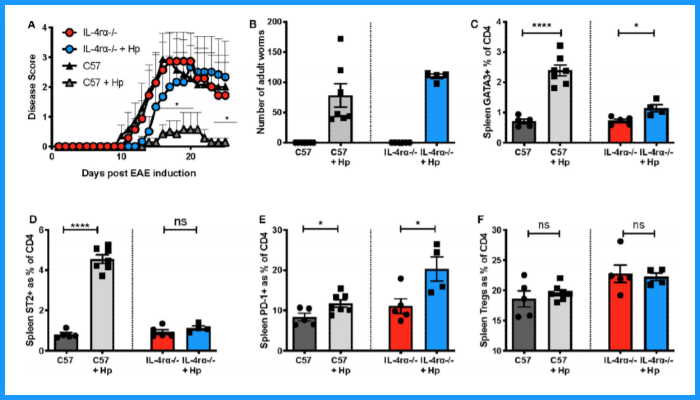The Helminth Parasite Heligmosomoides polygyrus Attenuates EAE in an IL-4Rα-Dependent Manner
Published: 12 October 2020
New research by Institute of Infection, Immunity and Inflammation scientists has determined the main mechanism by which H. polygyrus is capable of suppressing a model of Multiple Sclerosis (MS), with the findings building on previous work in the field indicating that Th2-biasing could be a potential therapeutic strategy for autoimmune diseases.

New research by Institute of Infection, Immunity and Inflammation scientists has determined the main mechanism by which H. polygyrus is capable of suppressing a model of Multiple Sclerosis (MS).
The study, led by the Institute's Dr Madeleine White and Professor Rick Maizels, was recently published in the journal Frontiers in Immunology.
Their investigation of how helminths suppress bystander inflammation has built on previous work in the field indicating that Th2-biasing could be a potential therapeutic strategy for autoimmune diseases such as MS.
Helminth parasites are a global health problem infecting over 25 per cent of the world’s population, mostly in tropical resource-poor areas.
However, helminths are also known to induce a state of host immune hypo-responsiveness that has been associated with a decreased incidence of inflammatory disease, and it was this suppression that was investigated.
The mouse intestinal helminth, H. polygyrus, mimics human hookworm and is capable of modulating the immune response through several mechanisms including inducing regulatory T cells.
In this study, researchers determined that Th2 immune deviation and IL-4Rα signaling is the main mechanism by which H. polygyrus is capable of suppressing a model of Multiple Sclerosis (MS).
Dr White explained: “The immune response is a complicated balancing act and it can be difficult to identify where things have gone wrong, particularly in autoimmune disease.
"But by studying how helminths suppress bystander inflammation we can learn something new about the immune system and apply that knowledge to create new and safer therapies.”
The Helminth Parasite Heligmosomoides polygyrus Attenuates EAE in an IL-4Rα-Dependent Manner
- Madeleine P. J. White, Chris J. C. Johnston, John R. Grainger, Joanne E. Konkel, Richard A. O'Connor, Stephen M. Anderton, and Rick M. Maizels.
- Front. Immunol., 29 September 2020 | https://doi.org/10.3389/fimmu.2020.01830
Image (figure 6):
H. polygyrus fails to protect against EAE in IL-4Rα-deficient mice. Female C57BL/6 or IL-4Rα-deficient mice were immunized for EAE on day 0 and were either left untreated or received 200 L3 H. polygyrus larvae also on day 0 (+Hp). (A) Disease course of EAE in uninfected and infected C57BL/6 wild-type and IL-4Rα-deficient mice. (B) Adult worm burdens in infected C57BL/6 wild-type and IL-4Rα-deficient mice at the time of euthanisation, day 26. (C) Frequency of CD4+ T cells expressing the Th2 marker, GATA3, in spleen at day 25 as measured using flow cytometry. (D) Frequency of CD4+ T cells expressing ST2 in spleen. (E) Frequency of CD4+ T cells expressing PD1 in spleen. (F) Frequency of Foxp3+ Tregs in the spleen. Data are from one of two similar independent experiments with n = 4–6 per group; (A) was tested by a 2-way ANOVA with Bonferroni's multiple comparisons test. (C–F) were statistically analyzed by unpaired t-tests with Welch's correction if SDs were not equal. Shown are the means ± SEM and *p < 0.05 and ****p < 0.0001.
First published: 12 October 2020

